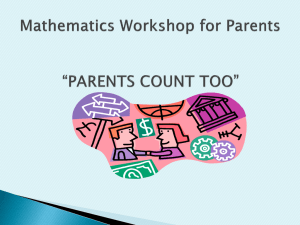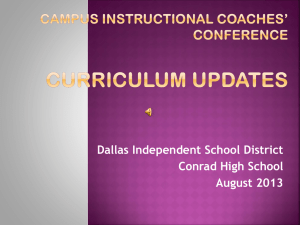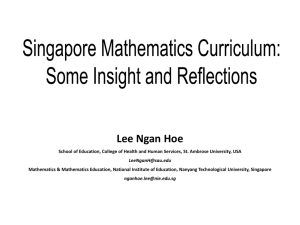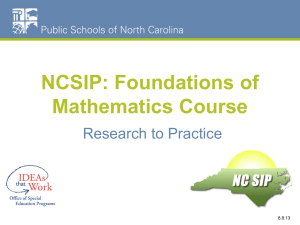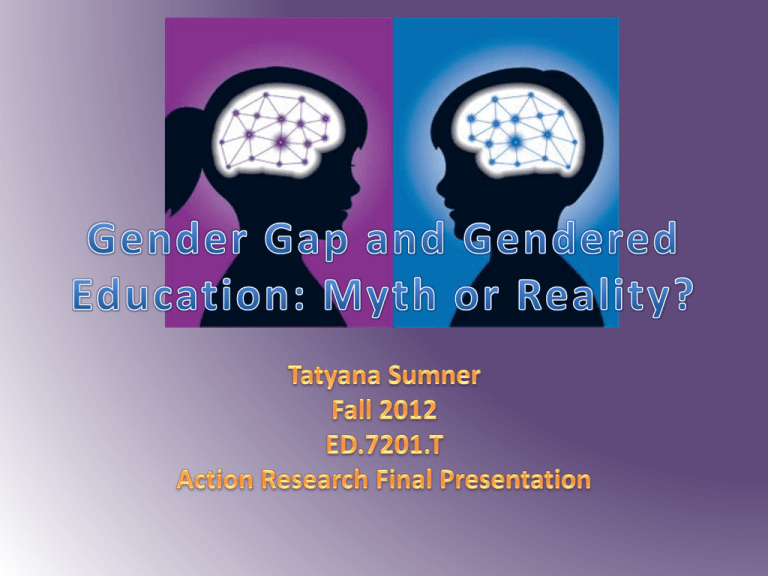
•
•
•
•
•
•
•
•
Statement of the Problem
Proposed Intervention
Literature Review
Theories
Hypothesis Statement
Method
Appendices
References
– slide 3
– slide 4
– slide 5-9
– slide 10
– slide 11
– slide 12
– slide 13-15
– slide 16-20
•
Living in a gendered society we learn that male and female are different in
many aspects. From anatomical and psychological variations to socially imposed
stereotypes, gender related issues can and often do affect our children’s
education (Ridgeway & Correll, 2004; Risman,2004).
•
There is a gross underrepresentation of women in math-related fields (Brandell
& Staberg 2008; Leaper et al., 2012; Steffens, Jelenec, & Noack, 2010).
•
Socially constructed stereotypes, such as “girls are not good at math,”
unconsciously and habitually reflect in both the educator’s instructions and
parental attitudes, which in turn can reflect in children’s achievement, selfconfidence and attitude toward mathematics (Guderson, Ramirez, Levine &
Beilock, 2012; Nosek, Banaji, & Greenwald, 2002; Tomasetto, Alparone, &
Cadinu, 2011; Tracy & Lane, 2006).
• In order to attempt to create a change in the
classroom, I believe that teachers should adjust
instructional strategies to minimize bias treatment and
reinforce heterogeneous, peer-learning environment.
• This proposal falls in opposition to single-sex education
practices that were legalized by the “No Child Left
Behind” act (Gurian, Stevens, & Daniels, 2009;
Herrelko, Jeffries, & Robertson, 2009).
• Gap exists in children’s academic achievement with boys
outperforming girls. Boys score above 600 on SATs 4 times more
often than girls (Ding, Song, & Richardson, 2006; Nosek et al.,
2002).
• There is a statistically insignificant gap in test results between boys
and girls (Gunderson et al, 2012; You, 2010).
• Girls outperform boys in mathematics (Geist & King, 2008).
• Girls are less likely to pursue higher mathematics or math-related careers
– gender gap in attitude (Brandell & Staberg, 2008; Steffens, Jelenec, &
Noack, 2010 James, 2007).
• Adhearing to gender stereotypes, girls associate themselves with literacy
and boys with mathematics Math = Male, Me = Female, Therefore Math ≠
Me (Leaper, Farkas, & Brown, 2012, Nosek et al, 2002; Steffens et al.,
2010).
• Girls attribute success to luck or hard work rather than talent (Steffens et
al., 2010; Stetsenko, Little, Gordeeva, Grasshof, & Oettingen, 2000).
•
Mathematics gender differences are genetic (Cambell, Verna, & O’Connor-Petruso;
James, 2007, You, 2010).
•
Mathematics gender differences are cognitive (Geary, Saults, Liu, & Hoard, 2000;
Moe, 2012)
•
Mathematics gender differences are result of diverse socialization (Cvencek,
Meltzoff, & Greenwald, 2011; Ding et al., 2006; Gool et al., 2006; Kane & Mertz,
2011; Nosek et al., 2012; You 2010).
•
Parental and teachers’ attitudes toward gender biases and math anxieties affect
children’s perceptions of their own achievements (Beilock, Gunderson, Ramirez and
Levine (2010); Eccels, Jackobs, and Harold, 1990; Gunderson et al, 2012).
•
Mathematics gender differences are result of equal amounts of biological and social
factors (Cambell et al, 2004; Pearce, 2003; Spinath, Spinath, & Plomin, 2008).
• Stereotype threat is a fear of one’s performance being judged
based on socially constructed, negative stereotype (Shapiro &
Williams, 2012; Spencer, Steele, & Quinn, 1999; Tomasetto,
Alparone, & Cadinu, 2011).
• Women underperform when exposed to stereotype threat
(Schmader, Johns, & Forbes, 2008; Shapiro & Williams, 2012;
Spencer et al., 1999).
• Parental endorsement or rejection of gender stereotypes affect
students’ vulnerability or resistance to stereotype threat
(Tomasetto et al., 2011).
• Educating teachers about gender bias and assisting them in recognizing signs in
their own behavior (Tracy & Lane, 1999).
• Differentiated instruction. Students should be taught in accordance with
cognitive gender differences (Geist & King, 2008; James, 2007).
• Single-gender classes. Students can benefit when genders are segregated and
instruction can be adjusted according to each gender’s learning and behavioral
differences (Gurian, Stevens, & Daniels, 2009; Herrelco, Jeffries, & Robertson,
2008).
• Students should be taught to work together in peer-assisted and cooperative
learning environments (Kroeger & Kouche, 2006; Kuntz, McLaughlin, & Howard,
2001; Sparks, 2012; Tournaki & Criscitiello, 2003).
• Provide girls with female role-models, support against stereotype threat and
encouragement in their abilities (Gool et al., 2007; Shapiro & Williams, 2012).
• Stereotype Threats – a psychological fear of being judged based on a
negative stereotype creates extra stress that disrupts and undermines
women’s performance in the circumstances. This theory has been applied
to education and gendered mathematics stereotypes. (Shapiro &
Williams, 2012; Spencer et al., 1998; Tomasetto et al., 2011 )
• Nature and Nurture - While there was a lot of debate whether biological
or social difference attribute to educational gaps in children’s academics,
Robert Plomin proposed that both elements, nature and nurture, must
have equal or near-equal contribution to the differences observed in the
development and educational studies. (Campbell, Verna, & O’ConnorPetruso, 2004; Pearce, 2003; Spinath, Spinath, & Plomin, 2008 )
1.
By creating teams of two (1 boy and 1 girl) during mathematics
instruction for the duration of the whole day, twice a week, for the
period of 10 weeks, in a classroom of 12 students (6 boys, 6 girls) in an
elementary school of Brooklyn, NY, will improve girls’ attitudes toward
mathematics.
1.
By creating teams of two (1 boy and 1 girl) during mathematics
instruction for the duration of the whole day, twice a week, for the
period of 10 weeks, in a classroom of 12 students (6 boys, 6 girls) in an
elementary school of Brooklyn, NY, will improve girls’ tests scores in
mathematics.
• A small group of 2nd grade students, 6 boys and 6 girls,
with an average age of 7 years old who attend
elementary school X in Brooklyn, New York.
•
•
•
•
• Cooperative pair-activity lesson
Initial math exam
plans
Initial questionnaire
• Instructions
End-of-study math exam
• Manipulatives
End-of-study questionnaire
• Exercise
Dear Parent/Guardian,
I am currently a student at Brooklyn College in the process of completing a Childhood Education Masters Program. As part of
our curriculum, I am conducting an action research to determine possible beneficial effects of peer-assisted and co-educational
learning instructional strategies on achievement in and attitude toward mathematics among boys and girls. Therefore, I am
requesting your permission to have your child participate in the implementation of aforementioned instructional strategies
and to use your child’s data that is relative to the research.
All instruction will be administered during your child’s regular classroom time, following the scheduled curriculum objectives.
Students will be given a mathematics test and a survey before and after implementation of the new instructional strategies.
Data collected from these sources will be reported as group findings; therefore, all participants’ names and other information
will remain anonymous. Additionally, at the end of the research I will gladly provide final results upon request.
If you have any additional questions or concerns please feel free to contact me by email vedmochka81@gmail.com
Thank you in advance for your support!
Sincerely,
Tatyana Sumner
I agree to my child, ________________________________________, participating in the action research described above.
(student’s name)
I do NOT agree to my child, __________________________________________, participating in the action research descried
above.
(student’s name)
Signature of Parent/Guardian ______________________________________ Date _________
Dear Principal,
I am currently a student at Brooklyn College in the process of completing a Childhood Education Masters Program. As part of
our curriculum, I am conducting an action research to determine possible beneficial effects of peer-assisted and coeducational learning instructional strategies on achievement in and attitude toward mathematics among boys and girls.
Therefore, I am requesting your permission to use one fourth-grade classroom in your school to implement the
aforementioned instructional for the duration of the research.
All instruction will be administered during regular classroom time, following the scheduled curriculum objectives. Modified
instruction will take place 3 times a week for the period of 6 weeks. Students will be given a mathematics test and a survey
before and after implementation of the new instructional strategies. Data collected from these sources will be reported as
group findings; therefore, all participants’ names and other information will remain anonymous. Additionally, at the end of
the research I will gladly provide final results upon request.
If you have any additional questions or concerns please feel free to contact me by email vedmochka81@gmail.com
Thank you in advance for your support!
Sincerely,
Tatyana Sumner
I, _______________________________________________, give permission to Tatyana Sumner to use one (1) fourth-grade
classroom for the action research as described above.
Signature of Principal ________________________________________ Date ______________
Dear Teacher,
I am currently a student at Brooklyn College in the process of completing a Childhood Education Masters Program. As part of
our curriculum, I am conducting an action research to determine possible beneficial effects of peer-assisted and coeducational learning instructional strategies on achievement in and attitude toward mathematics among boys and girls.
Therefore, I am requesting your participation and cooperation to implement the aforementioned instructional strategies in
your classroom for the duration of the research.
All instruction will be administered during regular classroom time, following the scheduled curriculum objectives. Modified
instruction will take place 3 times a week for the period of 7 weeks. Students will be given a mathematics test and a survey
before and after implementation of the new instructional strategies. Data collected from these sources will be reported as
group findings; therefore, all participants’ names and other information will remain anonymous. Additionally, at the end of
the research I will gladly provide final results upon request.
If you have any additional questions or concerns please feel free to contact me by email vedmochka81@gmail.com
Thank you in advance for your support!
Sincerely,
Tatyana Sumner
I, _______________________________________________, agree to participate in the action research as described above.
Signature of Teacher _________________________________________ Date ______________
•
•
•
•
•
•
Beilock, S. L., Gunderson, E. A., Ramirez, G., & Levine, S. C. (2010). Female teachers’
math anxiety affects girls’ math achievement. Proceedings of the National Academy of
Sciences of the United States of America, 107(5), 1860-1863.
doi:10.1073/pnas.0910967107
Brandell, G., & Staberg, E. (2008). Mathematics: A female, male or gender-neutral
domain? A study of attitudes among students at secondary level. Gender and
Education, 20(5), 495-509. doi:10.1080/09540250701805771
Campbell, J. R., Verna, M., and O’Connor-Petruso, S. (2004). Gender paradigms. Paper
presented at the IRC-2004 Conferences, Lefkosia, Cyprus. Retrieved from
http://www.iea.nl/fileadmin/user_upload/IRC/IRC_2004/Papers/IRC2004_Campbell_Ve
rna_etal.pdf
Cvencek, D., Meltzoff, A. N., & Greenwald, A. G. (2011). Math-gender stereotypes in
elementary school children. Child Development, 82(3), 766-779. doi:10.1111/j.14678624.2010.01529.x
Ding, C. S., Song, K., & Richardson, L. I. (2006). Do mathematical gender differences
continue? A longitudinal study of gender difference and excellence in mathematics
performance in the U.S. Educational Studies, 40(3), 279-295.
doi:10.1080/0013940701301952
Eccles, J. S., & Jacobs, J. E., & Harold, R. D. (1990). Gender role stereotypes, expectancy
effects and parents’ socialization of gender differences. Journal of Social Issues, 46(2),
183-201. doi:10.1111/j.1540-4560.1990.tb01929.x
•
•
•
•
•
•
•
Geary, D. C., Saults, S. J., Liu, F., & Hoard, M. K. (2000). Sex differences in special
cognition, computational fluency, and arithmetical reasoning. Journal of Experimental
Child Psychology, 77, 337-353. doi:10.1006/jecp.2000.2594
Geist, E. A., & King, M. (2008). Different, not better: Gender differences in mathematics
learning and achievement. Journal of Instructional Psychology, 35(1), 43-52. Retrieved
from Education Full Text Database
Gool, J., Carpenter, J., Davies, S., Ligos, T., MacKenzie, L., Schilp, R., & Schips, J. (2006).
Teacher bias of gender in the elementary classroom. Education Today, (5), 27-30.
Retrieved from Education Research Complete Database
Gunderson, E., Ramirez, G., Levine, S., & Beilock, S. (2012). The role of parents and
teachers in the development of gender-related math attitudes. Sex Roles, 66(3/4), 153166. doi:10.1007/s11199-011-9996-2
Gurian, M., Stevens, K., & Daniels, P. (2009). Single-sex classrooms are succeeding.
Educational Horizons, 87(4), 234-245. Retrieved from ERIC Database
Herrelko, J. M., Jeffries, K., & Robertson, A. (2009). The impact of single gender
elementary school on mathematics classes in an urban school.
scholarlypartnershipsedu, 4(1), 5-19. Retrieved from
http://opus.ipfw.edu/spe/vol4/iss1/2
James, A. N. (2007). Gender differences and the teaching of mathematics. Inquiry,
12(1), 14-25. Retrieved from ERIC Database
•
•
•
•
•
•
•
Kane, J. M., & Mertz, J. E. (2011). Debunking myths about gender and mathematics
performance. Notices of the American Mathematical Society, 59(1), 10-21.
doi:10.1090/noti790
Kroeger, S. D., & Kouche, B. (2006). Using peer- assisted learning strategies to increase
response to intervention in inclusive middle math settings. Teaching Exceptional Children,
38(5), 6-13. Retrieved from Academic Search Complete Database
Kuntz, K. J., McLaughlin, T. F., & Howard, V. F. (2001). A comparison of cooperative learning
and small group individualized instruction for math in a self contained classroom for
elementary students with disabilities. Educational Research Quarterly, 24(3), 41-56. Retrieved
from Academic Search Complete Database
Leaper, C., Farkas, T., & Brown, C. (2012). Adolescent girls’ experiences and gender-related
beliefs in relation to their motivation in math/science and English. Journal of Youth and
Adolescence, 41(3), 268-282. doi:10.1007/s10964-011-9693-z
Moe, A. (2012). Gender difference does not mean genetic difference: Externalizing improves
performance in mental rotation. Learning and Individual Differences, 22(1), 20-24.
doi:10.1016/j.lindif.2011.11.001
Nosek, B. A., Banaji, M. R., & Greenwald, A. G. (2002). Math = male, me = female, therefore
math ≠ me. Journal of Personality & Social Psychology, 83(1), 44-59. doi:10.1037//00223514.83.1.44
Pearce, J. (2003). Personal profile: Robert Plomin. Child & Adolescent Mental Health, 8(1), 40.
Retrieved from Academic Search Complete Database
•
•
•
•
•
•
•
•
Ridgeway, C. L., & Correll, S. J. (2004). Unpacking the gender system: A theoretical
perspective on gender beliefs and social relations. Gender & Society, 18(4), 510-531.
doi:10:1177/0891243204265269
Risman, B. J. (2004). Gender as a social structure: Theory wrestling with activism. Gender &
Society, 18(4), 429-450. doi:10.1177/0891243204265349
Schmader, T., Johns, M., & Forbes, C. (2008). An integrated process model of stereotype
threat effects on performance. Psychological Review, 115(2), 336-356. doi:10.1037/0033295X.115.2.336
Shapiro, J., & Willaims, A. (2012). The role of stereotype threats in undermining girls’ and
women’s performance and interest in STEM fields. Sex Roles, 66(3/4), 175-183.
doi:10.1007/s11199-011-0051-0
Sparks, S. D. (2012). Researchers cite social benefits in coed classes. Education Week,
31(30), 1-15. Retrieved from Academic Search Complete Database
Spencer S. J., Steele, C. M., & Quinn, D. M. (1999). Stereotype threat and women’s math
performance. Journal of Experimental Social Psychology, 35(1), 4-28.
doi:10.1006/jesp.1998.1373
Spinath, F. M., Spinath, B., & Plomin, R. (2008). The nature and nurture of intelligence and
motivation in the origins of sex differences in elementary school achievement. European
Journal of Personality, 22(3), 211-229. doi:10.1002/per.677
Steffens, M. C., Jelenec, P., &Noack, P. (2010). On the leaky math pipeline: Comparing
implicit math-gender stereotypes and math withdrawal in female and male children and
adolescents. Journal of Educational Psychology, 102(4), 947-963. doi:10.1037/a0019920
• Stetsenko, A., Little, T. D., Gordeeva, T., Grasshof, M., & Oettingen, G.
(2000). Gender effects in children’s beliefs about school performance: A
cross-cultural study. Child Development, 71(2), 517-527.
doi:10.1111/1467-8624.00161
• Tomasetto, C., Alparone, F., & Cadinu, M. (2011). Girls’ math performance
under stereotype threat: The moderating role of mothers’ gender
stereotypes. Developmental Psychology, 47(4), 943-949.
doi:10.1037/a0024047
• Tournaki, N., & Criscitiello, E. (2003). Using peer tutoring as a successful
part of behavior management. Teaching Exceptional Children, 36(2), 22-29.
Retrieved from
http://www.cec.sped.org/Content/NavigationMenu/Publications2/TEACHI
NGExceptionalChildren/default.htm
• Tracy, D. M., & Lane, M. B. (1999). Gender-equitable teaching behaviors:
Preservice teachers’ awareness and implementation. Equity & Excellence
in Education, 32(3), 93-104. doi:10.1080/1066568990320311
• You, Z. (2010). Research in brief: Gender differences in mathematics
learning. School Science and Mathematics, 110(3), 115-117.
doi:10.1111/j.1949-8594.2010.00028.x


